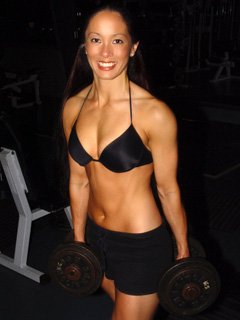There are many products in the supplement industry that are used in pursuit of muscle accretion, strength gains, or fat loss. One such product is a testosterone booster. Testosterone boosters are generally avoided by females (and sometimes recommended against), due to the fear that they will cause androgenic side effects (which they will not), because of ignorance on how the product affects the female physiology.
Then there is the other side of the coin, where females look to (and males recommend) a testosterone booster, believing that by elevating their testosterone levels they will get faster gains and experience the same results as a male with increased testosterone. Both ideas are inaccurate.
This section will focus on the latter, discussing the endogenous female response of testosterone to resistance exercise; and which hormone/s should be optimized to provide muscle accretion, strength gains, or fat loss in women.
Hormones
Alongside resistance training anabolic hormones play an important role in hypertrophy, strength gains, and leanness. Two of the anabolic hormones in the body are testosterone and rrowth hormone (GH) (Kraemer, 1988).

{{caption}}
Testosterone
Whilst testosterone levels in females may influence physiological adaptations to resistance training, studies indicate that muscle accretion and strength gains happen with or without an increase in testosterone (Kraemer & Ratamess, 2005). Subjects of Hickson, Hidaka, Foster, Falduto & Chatterton (1994) increased both muscle mass and strength over a 16-week period of resistance training, with no change in testosterone levels.
Although research has been inconsistent with resistance training effects on females' resting testosterone levels (Kraemer & Ratamess, 2005), chronic resistance training (i.e. >6 months) has been shown to increase resting (and post-exercise) free testosterone in females (Häkkinen, Pakarinen, Kraemer, Newton & Alen, 2000; Marx, et al., 2001), suggesting that long-term training is required to elicit a hormonal response.
Studies also indicate that there is no difference in testosterone levels between heavily trained female athletes and sedentary controls (Tegelman, et al., 1990). However, increases in strength and power have been correlated with pre-training testosterone levels (Krahenbuhl, Archer & Pettit, 1978), leading Hakkinen, et al. (2000) to hypothesize that testosterone levels in females are indicative of their trainability (although not necessarily of their results).
Growth Hormone
It has been suggested that other anabolic hormones, such as GH may be responsible for hypertrophy, strength gains, and leanness in females (Kraemer & Ratamess, 2005), since such results are achieved without changes in testosterone levels.
Females naturally have higher GH levels than males (Engstrom, Karlsson & Wide, 1998; Wideman, Weltman, Hartman, Veldhuis & Weltman, 2002).

Exercise is a physiological stimulus for GH release, with resistance training inducing significant GH secretion. The magnitude of exercise induced GH release in females is greater than that in males (Wideman, et al., 2002).
Multiple set resistance exercise increases and prolongs the GH response in females compared to single sets (Mulligan, et al., 1996); and resistance training with higher volume elicits a greater GH response than low volume training (Kraemer, et al., 1993). The largest female GH responses are observed with longer resistance sessions with high total work using moderately to heavy weights (>70% 1RM) and shorter recovery periods (Kraemer, et al., 1993).
Whilst acute resistance training has been shown to elevate resting levels of GH in females, chronic resistance training has not. However, chronic resistance training still elicits a similar exercise induced GH response pre and post acute resistance training (McCall, et al., 1999).
Muscle accretion, strength gains, or fat loss in a female are NOT dependent upon their testosterone levels. There are many factors involved in each goal achievement, including an increase in all anabolic hormones. Products that increase GH (or both GH and testosterone) would be a better option than utilizing just a testosterone booster, for the female looking to optimize hypertrophy, strength, or leanness.
References:
- Cumming, D.C., Wall, S. R., Galbraith, M. A. & Belcastro, L. N. (1987). Reproductive hormone responses to resistance exercise. Med Sci Sports Exerc, 19(3). (p. 234-238).
- Engstrom, B. E., Karlsson, F. A. & Wide, L. Marked gender differences in ambulatory morning growth hormone values in young adults. Clin Chem, 44(6). (p. 1289-1295).
- Häkkinen, K., Pakarinen, A., Kraemer, W. J., Newton, R. U. & Alen, M. (2000). Basal concentrations and acute responses of serum hormones and strength development during heavy resistance training in middle- aged and elderly men and women. J Gerontol A Biol Sci Med Sci, 55A(2). (p. B95-B105).
- Hickson R. C., Hidaka, K., Foster, C, Falduto, M. T., & Chatterton, R. T. Jr. (1994). Successive time courses of strength development and steroid hormone responses to heavy-resistance training. J Appl Physiol, 76(2). (p. 663-670).
- Kraemer, W. J. (1988). Endocrine responses to resistance exercise. Med Sci Sports Exerc, 20(5). (p. S152-S157).
- Kraemer, W. J., Fleck, S. J., Dziados, J. E., Harman, E. A., Marchitelli, L. J., Gordon, S. E., Mello, R., Frykman, P. N., Koziris, L. P. & Triplett, N. T. (1993). Changes in hormonal concentrations after different heavy-resistance exercise protocols in women. J Appl Physiol, 75(2). (p. 594-604).
- Kraemer, W. J. & Ratamess, N. A. (2005). Hormonal responses and adaptations to resistance exercise and training. Sports Med, 35(4). (p. 339-361).
- Kraemer, W.J., Staron, R. S., Hagerman, F.C., Hikida, R. S., Fry, A. C., Gordon, S. E., Nindl, B.C. & H?kkinen K. (1998). The effects of short-term resistance training on endocrine function in men and women. Eur J Appl Physiol,78(1). (p. 69-76).
- Krahenbuhl, G. S., Archer, P. A., & Pettit, L. L. (1978). Serum testosterone and adult female trainability. J Sports Med, 18.(p. 359-364).
- Marx, J.O,, Ratamess, N. A., Nindl, B. C. Gotshalk, L. A., Volek, J. S., Dohi, K. Bush, J. A., Gomez, A. L., Mazzetti, S. A., Fleck, S. J., Hakkinen, K., Newton, R. U. & Kraemer, W. J. (2001). Low-volume circuit versus high-volume periodized resistance training in women. Med Sci Sports Exerc, 33(4). (p. 635-643).
- McCall, G. E., Byrnes, W. C., Fleck, S. J., Dickinson, A. & Kraemer, W. J. (1999). Acute and chronic hormonal responses to resistance training designed to promote muscle hypertrophy. Can J Appl Physiol, 24(1). (p. 96-107).
- Mulligan, S. E., Fleck, S. J. Gordon, S. E., Koziris, L. P., Triplett-McBride, N. T. & Kraemer, W. J. (1996). Influence of resistance exercise volume on serum growth hormone and cortisol concentrations in women. J Strength Cond Res, 10(4). (p. 256-262).
- Nindl, B. C., Kraemer, W. J., Gotshalk, L. A., et al. (2001). Testosterone responses after resistance exercise in women: Influence of regional fat distribution. Int J Sport Nutr Exerc Metab, 11(1). (p. 451-165).
- Tegelman, R., Johansson, C., Hemmingsson, P., EklOf, R., Carlstrom, K., & Pousette, A. (1990). Endogenous anabolic and catabolic steroid hormones in male and female athletes during off season. Int J Sports Med, 11(2). (p. 103-106).
- Wideman, L., Weltman, J. Y., Hartman, M. L., Veldhuis, J. D. & Weltman, J. (2002). Growth hormone release during acute and chronic aerobic and resistance exercise. Sports Med, 32(15). (p. 987-1004).

